Ever wondered what ABET is!
If so, you have reached the right place.
Accreditation refers to the full-fledged process of reviewing or evaluating if the educational programs meet the quality standards or not. Once it is attained, the accreditation is supposed to get assessed occasionally to ascertain that the consistency of the quality educational program is retained. This process of accreditation includes a team of skilled professionals who are in charge of carrying out a quality review process. These experts invest their time, expertise and knowledge towards the constant improvement of education while promoting quality assurance.
What is ABET?
ABET is referred to as the Accreditation Board for Engineering and Technology, which is a non-governmental organisation that assures and ensures quality standards, boosts confidence and aims at creating a better world- one that is more accessible and sustainable. It accredits college programs with disciplines like natural science, computing, engineering technology, etc. ABET accreditation instils the students and employers with promising quality programs and prepares them well. They focus on enhancing students’ learning experience also, they have a review process that is highly regarded and adds value to the academic disciplines, where quality is considered supreme. Many experts invest their time and effort by building something qualitative while serving as evaluators and advisors.
Why is ABET important?
ABET accreditation ensures that a collegiate program has set quality standards, necessary to equip the learners or graduates under STEM fields in the workforce. Students who have obtained the ABET-accredited program have a solid educational platform and are given the exposure to lead innovation, invention, etc.
Why is ABET important for you as a student?
The quality of education a student attain decides, determines and marks a huge difference in their career growth. With, ABET accreditation, learners are likely to amass the following experience that includes:
- Validates whether the educational experience you have fulfils the global standards for education (under your profession) or not.
- With accredited programs, you are likely to witness expansion in job opportunities, as reputed or renowned multinational companies hire the graduates who have attained this accreditation.
- Undoubtedly, you are going to witness your eligibility for various purposes like scholarships or loans.
- The ABET accreditation serves you with a swarm of opportunities by allowing you to work globally, as such a program is widely recognised by international agreements; many counties also support such an ABET model of accreditation.
- With the ABET accreditation program, you are likely to have gained the chance to pursue a technical profession through a full-fledged process of registration, certification, etc. But for that, the minimum requirement or eligibility is an ABET-accredited program.
Why is ABET important for you as an institution?
In ABET accreditation, many skilled professionals and institutions support every aspect of this process. In addition, they understand the significance of evaluating the academic programs while ensuring the upcoming workforce is well equipped with professional skills or not. They do so as they know the nature of this profession. Undoubtedly, ABET accreditation includes a more thorough review process. And yet, more than thousands of institutes carry out this process.
ABET accreditation is likely to help you in understanding the following factor (about your program) :
- Whether you have attained or acquired qualitative international recognition.
- Encouraging best practices involved in education.
- Including the faculty and staff in ensuring quality processes of self-assessment and improvement.
- Depending on the learning outcomes instead of the teaching inputs.
- Finding you eligible for accepting your transfer credits.
ABET Accreditation process – The Timeline
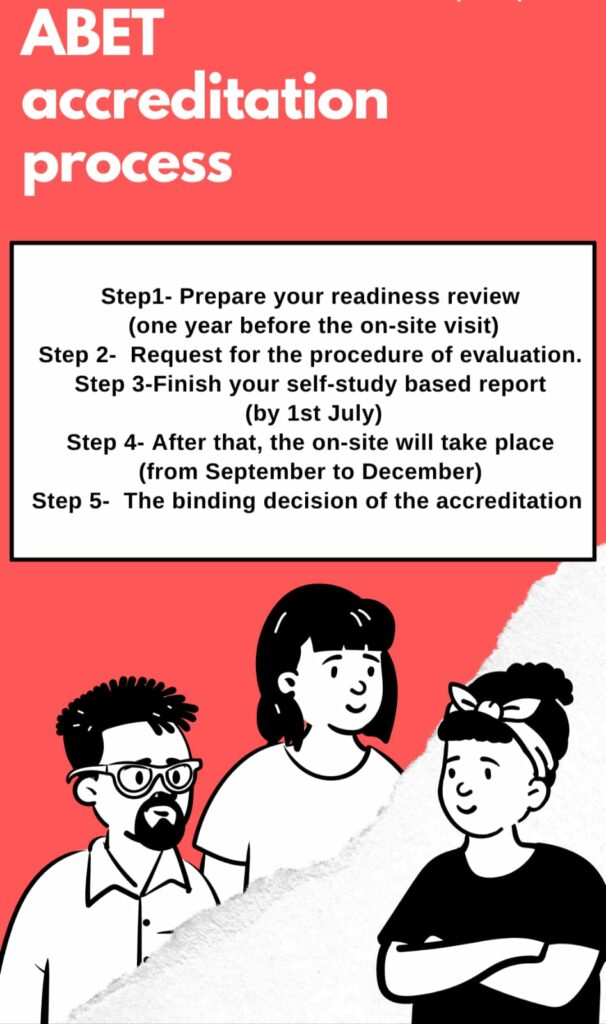
ABET Accreditation is a full-fledged process. The crucial steps that are involved and incorporated under such an intensive procedure are as follows:
Step 1- Prepare a readiness review (one year before the on-site visit)
- Gather and collect the samples of assignments, student work, etc.
- Prepare a readiness review- The readiness review acknowledges if your program is ready for evaluation before choosing to opt for an on-site visit.
- Try to finish your readiness review by 1st October.
Step 2- Request for the procedure of evaluation.
- Try and submit your request for Evaluation latest by 31st January in the year of your on-site visit.
- The institution will allocate you the day for the on-site visit while scheduling a review somewhere between April and May.
Step 3 – Finish your self-study based report (by July 1st)
- Try to complete the self-study report within a stipulated time of 1st July.
- After that, the team is likely to schedule your review of your self-study report.
- A self-study report is referred to as one of the crucial documents that ensure if your program is found preferable in compliance with the ABET criteria or not. In addition, the review team will examine your report and put forward their binding decision on whether the program meets the needs and demands of the accreditation or not.
- Then, attend the Institutional Representation Day at a July commission meeting. Here, your (program’s) institutional representative joins the review team at this event.
Step-4 After that, the on-site will take place (from September- December)
Prepare and equip yourselves for the on-site visit. Confirm your visit schedules, interviews and then finally assemble the materials needed for the review team (start preparing and planning)
Your on-site visit takes around three days. It also demands an intensive review of your materials; your interviews with faculty and staff. Yet, it will be concluded by an exit meeting, where the team will convey its final decision.
Step-5. The binding accreditation decision
After a week, you can present to the review team if there are any modifications in case of any errors that occurred during the presentations.
- After 2-3 months, your institution will receive the statement on your draft, more like proper communication based on your review team’s findings.
- After 3-4 months, with a 30-days process, the institution will put forward any drawbacks found on your draft statement.
- In July, the ABET commission holds a meeting to decide on the criteria of Accreditation action. Here, your program’s accreditation is discussed by the team.
- On August 31st, your program will be notified or informed of the accreditation judgment through a final decision or a statement of the Institution.
Comparison between NBA Vs NAAC Vs ABET
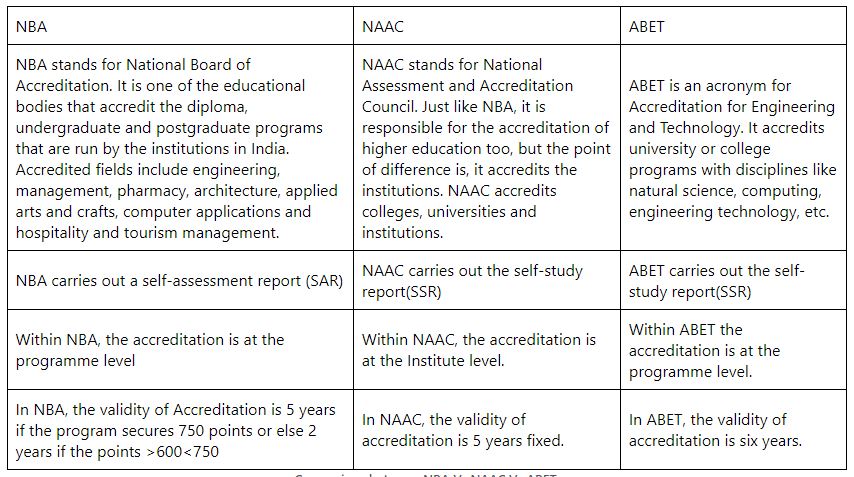
Assessment planning for ABET
Assessment planning lays a solid foundation for ensuring the program’s success. And here, the planning procedure is accompanied by three main criteria that are:
- Program Educational Objectives
- Student Outcomes
- Continuous improvement
To study these factors in detail, let us understand the following points.
- Establish a purpose & define goals
In the initial phase of assessment planning, any institution should have its mission statement, i.e., the goals and purposes that define the institution’s expectations. Along with this, the assessment leader should collaborate and work with the faculty to devise a plan of action while setting the timeline that would ensure if all the assessment based goals are strictly followed based on the given deadlines or not.
- Specify the program’s educational objectives and student-based outcomes
The program’s educational objectives are referred to as the purposes or goals based on the institutional needs. It also describes what the graduates are expected to fulfil or attain after their graduation.
Student based outcomes refer to skills, knowledge and other abilities that a student is likely to gain as they proceed with the program. It also decides what the learners are expected to achieve towards the end of their graduation. In total, specifying the program’s educational objectives along with the student outcomes, allows the faculty to strategize the goals for their learning, while ensuring consistency of curriculum, as per the expected plans.
- Designing the framework and conducting the assessment.
We know that it is vital to design the educational framework and conduct the assessments to evaluate the student-based outcomes. However, with such assessments, you are likely to obtain insights using qualitative and quantitative measures. Also, sampling methods are to be used in designing the framework too.
Most importantly, one needs to adopt assessment strategies effectively. But for that, you need to understand the difference between educational strategies and practices. It can be understood by highlighting the strategies and the learning outcomes.
In addition, one needs to know the methods of data collection, which have to be carefully examined while focusing on the assessments.
- Analyze the assessment findings.
Evaluation can indeed proceed when you gather or accumulate the required data. After doing so, you get to analyse the assessment findings and know about the educational objectives that are acquired or achieved. However, these findings have to ensure that whatever decisions are considered will be implemented to enhance the program.
- Desired results will help us come to a final decision.
The assessment helps us devise a structured framework that allows us to record the feedback. Such a process is highly crucial in helping us arrive at a final decision. Indeed, it will uplift our decision-making but would also maintain the quality assurance to keep our program pertinent to the profession (it promises to serve). It also supports excellent experience and assures that the graduates are well prepared for their upcoming professional careers.
Conclusion
ABET accreditation is one of the effective bodies of accreditation that assures quality experience to the students. In addition, about 175,000 students graduate from ABET-accredited programs every year, and millions of graduates have even earned degrees from ABET-accredited programs since the year 1932. It still continues to rule while setting the quality standards worldwide.

About the Author: Hansika Bhardwaj
Hansika is a proud content writer and enthusiastic person who is willing to embrace the journey. She loves writing poetry when not spending her time researching on education and education technology. She believes and manifests the ideals of hope, magic and positivity. Hansika is currently a student in Humanities Dept. at University of Delhi.
This article has been re-published on Medium
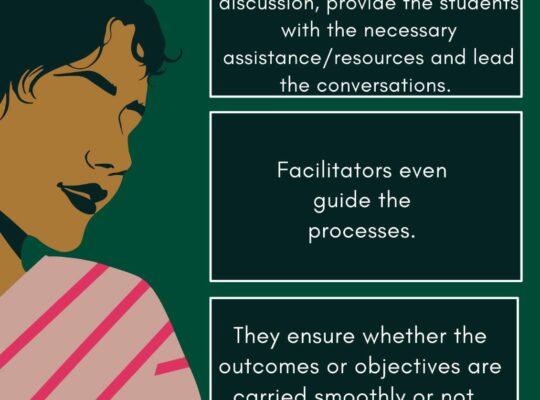
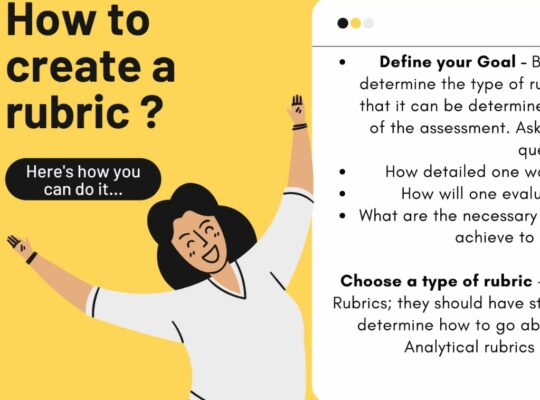
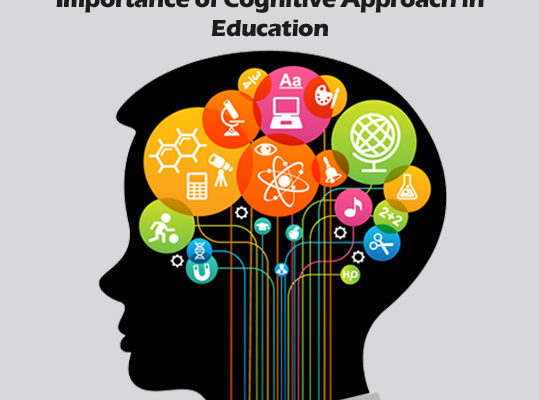

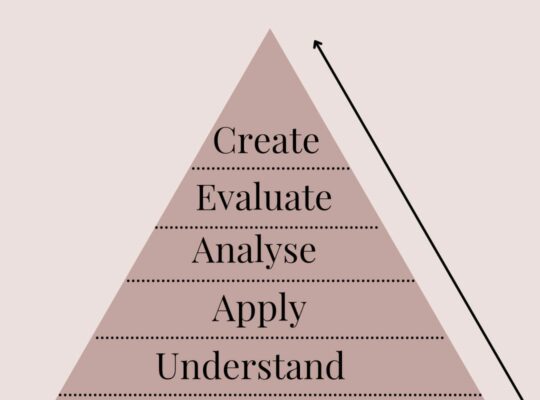
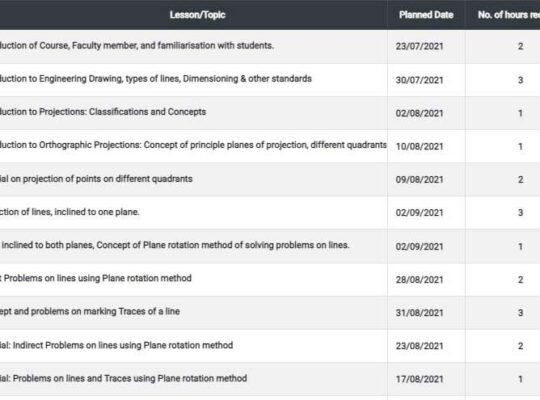
Very informative
Impressive! Keep going This article gives clear idea and well written 👏🙌
Very Informative! Keep going Hans